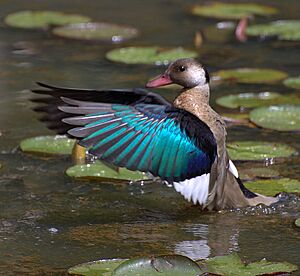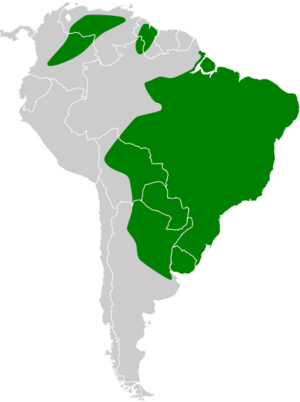Brazilian teal facts for kids
Quick facts for kids Brazilian teal |
|
|---|---|
 |
|
| Conservation status | |
| Scientific classification | |
| Genus: |
Amazonetta
|
| Species: |
brasiliensis
|
| Subspecies | |
|
See text |
|
 |
|
The Brazilian teal or Brazilian duck (Amazonetta brasiliensis) is a type of duck that lives in eastern South America. It's the only duck in its special group, called a genus, named Amazonetta.
Contents
About the Brazilian Teal
Naming and History
The Brazilian teal was first officially described in 1789. A German scientist named Johann Friedrich Gmelin gave it its scientific name, Anas brasiliensis. He put it in the same group as other ducks and geese.
Later, in 1929, another German scientist, Hans von Boetticher, created a new group just for this duck. He named this group Amazonetta. So now, the Brazilian teal is the only species in the Amazonetta genus.
Scientists used to think this duck was a "perching duck." But newer studies show it's actually related to other South American "dabbling ducks." These include the crested duck and the bronze-winged duck.
There are two main types, or subspecies, of the Brazilian teal:
- A. b. brasiliensis (Gmelin, 1789) – This type is found in Brazil, Suriname, Guyana, French Guiana, central Venezuela, eastern Colombia, and northeastern Peru.
- A. b. ipecutiri (Vieillot, 1816) – This type lives in Brazil, northern Argentina, eastern Bolivia, Uruguay, and Paraguay.
What They Look Like
Brazilian teals are mostly light brown. You can tell the males (called drakes) apart from the females.
- Males have bright red beaks and legs. They also have a light gray patch on the side of their head and neck.
- Females have duller colored beaks and legs.
Where They Live
These ducks live across eastern South America. You can find them in countries like Brazil, Uruguay, Argentina, Paraguay, Venezuela, Peru, Suriname, Guyana, French Guiana, Bolivia, and Colombia.
They like to live near freshwater bodies, like ponds or slow-moving rivers. They prefer places that have lots of plants growing nearby.
How They Behave
Brazilian teals often live in pairs or in small groups. Sometimes, you might see a group of up to twenty birds together. Both the mother and father duck help take care of their young ducklings.
Their diet includes seeds, fruits, roots, and insects. Young ducklings, however, eat only insects.
Conservation Status
The Brazilian teal is quite common. Because there are so many of them, they are listed as a species of Least Concern. This means they are not currently in danger of disappearing.





